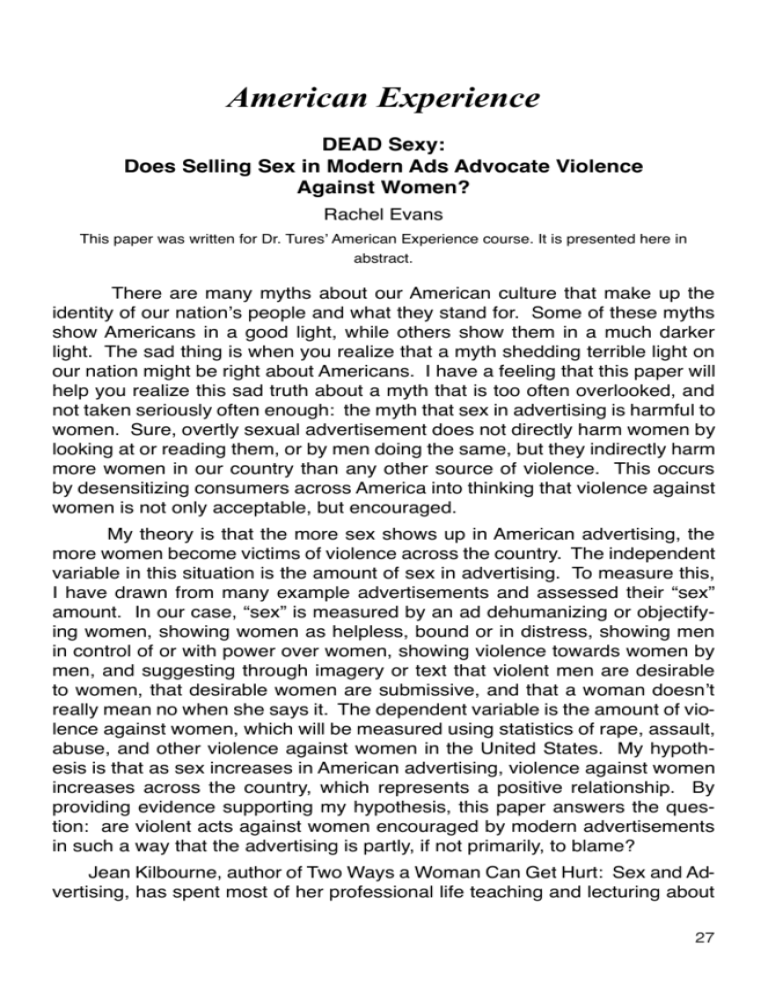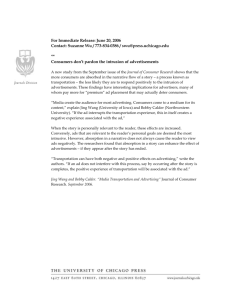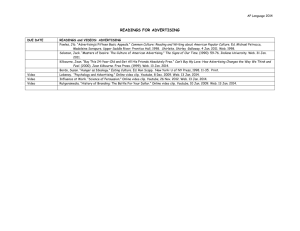
American Experience
DEAD Sexy:
Does Selling Sex in Modern Ads Advocate Violence
Against Women?
Rachel Evans
This paper was written for Dr. Tures! American Experience course. It is presented here in
abstract.
There are many myths about our American culture that make up the
identity of our nation!s people and what they stand for. Some of these myths
show Americans in a good light, while others show them in a much darker
light. The sad thing is when you realize that a myth shedding terrible light on
our nation might be right about Americans. I have a feeling that this paper will
help you realize this sad truth about a myth that is too often overlooked, and
not taken seriously often enough: the myth that sex in advertising is harmful to
women. Sure, overtly sexual advertisement does not directly harm women by
looking at or reading them, or by men doing the same, but they indirectly harm
more women in our country than any other source of violence. This occurs
by desensitizing consumers across America into thinking that violence against
women is not only acceptable, but encouraged.
My theory is that the more sex shows up in American advertising, the
more women become victims of violence across the country. The independent
variable in this situation is the amount of sex in advertising. To measure this,
I have drawn from many example advertisements and assessed their “sex”
amount. In our case, “sex” is measured by an ad dehumanizing or objectifying women, showing women as helpless, bound or in distress, showing men
in control of or with power over women, showing violence towards women by
men, and suggesting through imagery or text that violent men are desirable
to women, that desirable women are submissive, and that a woman doesn!t
really mean no when she says it. The dependent variable is the amount of violence against women, which will be measured using statistics of rape, assault,
abuse, and other violence against women in the United States. My hypothesis is that as sex increases in American advertising, violence against women
increases across the country, which represents a positive relationship. By
providing evidence supporting my hypothesis, this paper answers the question: are violent acts against women encouraged by modern advertisements
in such a way that the advertising is partly, if not primarily, to blame?
Jean Kilbourne, author of Two Ways a Woman Can Get Hurt: Sex and Advertising, has spent most of her professional life teaching and lecturing about
27
DEAD Sexy: Does Selling Sex in Modern Ads Advocate Violence Against Women?
advertising. She comments in Two Ways... that, “Sex in advertising is more
about disconnection and distance than connection and closeness. It is also
more about power than passion, about violence than violins. The main goal,
as in pornography, is usually power over another, either by physical dominance or preferred status of men, or what is seen as the exploitative power of
the female beauty and female sexuality.” (417) In short, with the aid of a product, advertisements tell us that men conquer and women ensnare. Women
are objectified and dehumanized in advertising when products are attached,
via the actual ad, to an erotic charge. Ads do this using a combination of
seemingly “sexy” images and words that tell you, directly or indirectly, what the
other sex expects of you, and what you should expect and desire from the opposite sex. Of course, such advertisements only disappoint us since products
cannot ever fully meet our sexual or emotional needs. Kilbourne contends that
advertising today is more influenced by pornography than anything else. “The
poses and postures of advertising are often borrowed from pornography,” she
explains, “as are many of the themes, such as bondage, sadomasochism, and
the sexual exploitation of children”. (417)
In addition to analyzing advertisement examples (including: Dolce & Gabbana, Vogue, Calvin Klein Jeans, American Apparel, Lee Jeans, OPp Sportswear, Skyy Vodka, Herbal Essence, Axe and Tag body spray, Icon Shoes,
Louis Vuitton, Ceare Paciotti, Camel Cigarettes, Tipalet Cigars, Sisley Clothing, Hitman video game and Jensen speakers), I have also conducted a study
on the amount of harmful ads towards women in magazine ads. The study
looks at 26 issues of Time magazine. The study goes on to compare the number of harmful ads toward women in different types of magazines using current
issues of Paste, Guitar World, Filter, Spin, Rolling Stone and Alternative Press
as examples. Finally, statistics from the Rape, Abuse and Incest National Network!s most recent surveys are used to determine how the media in recent
year!s has effected the number of incidents of reported abuse, assault and
rape cases in the United States (RAINN.org).
In conclusion, although the number of sexual assault victims in our country is staggering at the moment, it has significantly decreased over the past
decade or so, despite the increased amount of sex that advertisements are
using to sell their products. Still, the number of sexual assaults that occur in
our country is much more than our nation should be comfortable with. As a
result of the violence encouraged by advertisements (which is just one facet
our vast mass-media in America uses “sex” to sell), women across America
are in constant fear of violence and rape day after day. So, although no direct
correlation can be drawn between the number of increasing ads capitalizing on
the pressures of men and women to be DEAD sexy and the number of sexual
assaults happening every day, there is still a great injustice being served to
28
Rachel Evans
women in advertising due to the gender stereotypes portrayed in our society!s
media.
If you would like to read the complete paper, along with advertisement plates,
you can download the PDF at: http://home.lagrange.edu/rsevans.
Bibliography
Abbey, A., L. Ross, and D. McDuffie. Addictive Behaviors in Women: Alcohol!s Role in Sexual Assault. Totowa, NJ: Human P, 1991. 230-37.
Kilbourne, Jean. “Two Ways A Woman Can Get Hurt: Sex and Advertising.”
Rereading America: Cultutal Contexts for Critical Thinking and Writing.
By Gary Colombo, Robert Cullen and Bonnie Lisle. 7th ed. Boston: Bedford/Saint Martin!s, 2007. 417-11.
Plaud, J. J., and A. D. Klassen. “Sexuality, Gender and Alcohol Use.” Gender
and Alcohol: Individual and Social Perspectives. Ed. S. C. Wilsnack and
R. W. Wilsnack. New Brunswick, NJ: Butgers Center of Alcohol Studies,
1997. 262.
U.S. Department of Justice. “How Often Does Sexual Assault Occur?”
RAINN.org. 2008. Rape, Abuse and Incest National Network. 2 Nov.
2008 <http://www.rainn.org/get-information/statistics/frequency-of-sexu
al-assault>.
U.S. Department of Justice. “Who Are The Victims?” RAINN.org. 2008. Rape,
Abuse and Incest National Network. 2 Nov. 2008. <http://www.rainn.org/
get-information/statistics/sexual-assault-victims>.
29









